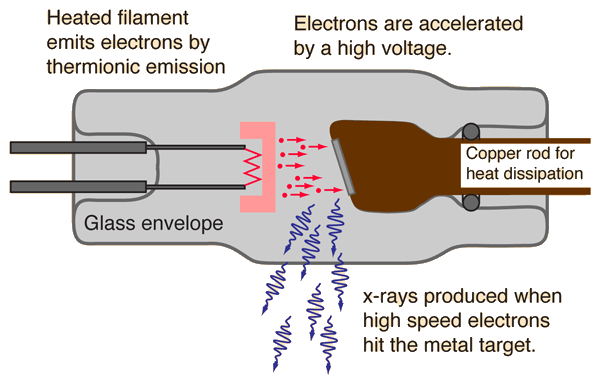X-rays play a very important role in many fields, especially in medicine. X-ray images of internal organs are used extensively in medicine as a diagnostic tool. An X-ray technique called computer-assisted tomography (CAT) enables a clearer view of the structure of any part of the body without any need for surgery.
X-rays are a form of electromagnetic radiation. The wavelength of X-rays are in the range of .01 to 10 nanometers. Shorter than UV rays, longer than gamma rays. X-rays are also classified into two classes, 'soft' x-rays and 'hard' x-rays respectively.
Needless to say, hard x-rays have greater penetrating power. That's the only major distinguishing factor.
So...
X-rays. What do you know about them? Nothing? How are they produced?
We're going to paint a basic picture about the production of x-rays.
 |
| Literally. |
Electrons are emitted through thermionic emissions when the filament is heated by current flowing in it. The electrons are accelerated towards the copper anode by the high potential difference ranging from 10^4 V to 10^6 V between the anode and the cathode.
The glass tube is evacuated so that the electrons are pulled towards the anode at a very high speed without colliding with air molecules.
The electrons decelerate rapidly on impact with the target. As a result, some of the kinetic energy is converted into X-rays. Less than 1% of the total energy supplied to the X-ray tube is converted into X-rays, the remainder is released as heat.
So inefficient.
The target metal must be made of heavy metals with a high melting point such as molybdenum or tungsten, to prevent the target from melting easily.
X-rays of short wavelength and high penetrating power are called HARD X-rays. X-rays of long wavelength and low penetrating power are called SOFT X-rays.
Minimum wavelength, λmin = hc/eV


Curious post, i had seen many detectors, but never realized how they worked.
ReplyDeleteNice post.
I have to say, this was very interesting. never knew how it actually worked.
ReplyDeleteVery interesting to know how those thinks really work and its very easy to understand! Thanks for the nice post :)
ReplyDeletewait wait wait wait, suddenly it hit me.. for xrays of body parts, the white part /bones is the part of the sheet that was hit with less xray radiation...the black parts is what got hit fully... so that means our body keeps a lot of it... D:!
ReplyDelete